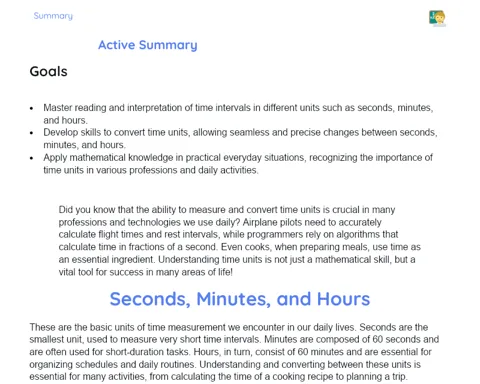Addition and Subtraction of Decimal Numbers | Socioemotional Summary
Objectives
1. ✨ Understand the essential properties of adding and subtracting decimal numbers.
2. 🧠 Solve practical problems involving the addition and subtraction of decimal numbers using various strategies.
3. 💬 Develop socio-emotional skills, such as self-awareness and emotional regulation, during the learning of mathematics.
Contextualization
Have you ever wondered how to calculate the change from a purchase, split the restaurant bill with your friends, or even manage your daily money? All these activities involve the addition and subtraction of decimal numbers! Learning these operations not only helps you in school but also prepares you to deal with real situations in a practical and efficient way. Let's explore together this universe of decimals and discover how useful and fascinating it is! #AddingIsLife
Important Topics
Definition of Decimal Numbers
Decimal numbers are numbers that have an integer part and a fractional part, separated by a comma. They are essential for representing values between whole numbers, allowing for more precise and detailed calculations in various everyday situations, such as measurements and financial transactions.
-
📌 Integer and Fractional Part: A decimal number consists of an integer part (to the left of the comma) and a fractional part (to the right of the comma).
-
📌 Example: In the number 12.45, 12 is the integer part and 45 is the fractional part.
-
📌 Precision in Calculations: Using decimal numbers allows for greater precision, especially in financial and scientific calculations.
Properties of Adding Decimal Numbers
The addition of decimal numbers follows the same properties as whole numbers, making it easier to understand and apply the rules of integers to decimals. This includes properties such as commutativity and associativity, which allow you to add numbers in any order and group them in different ways without changing the result.
-
📌 Commutative Property: The order of the factors does not change the sum (e.g., 3.2 + 2.8 = 2.8 + 3.2).
-
📌 Associative Property: The way of grouping the factors does not change the sum (e.g., (1.1 + 2.2) + 3.3 = 1.1 + (2.2 + 3.3)).
-
📌 Aligning Commas: To add correctly, align the commas of the numbers to ensure that each decimal place corresponds correctly.
Properties of Subtracting Decimal Numbers
Just like in addition, the subtraction of decimal numbers follows properties similar to whole numbers. This includes the importance of aligning the commas and understanding that subtracting a number is the same as adding its opposite, a useful strategy for solving more complex problems.
-
📌 Subtraction Property: Subtracting one number from another is the same as adding its opposite (e.g., 5.7 - 2.3 is the same as 5.7 + (-2.3)).
-
📌 Aligning Commas: Align the commas to ensure that the subtraction is done correctly, properly considering the decimal places.
-
📌 Verification of the Result: After performing the subtraction, check the result by adding the remainder to the original minuend to ensure that the operation was performed correctly.
Key Terms
-
Decimal Numbers
-
Integer Part
-
Fractional Part
-
Commutative Property
-
Associative Property
-
Aligning Commas
-
Subtraction Property
To Reflect
-
🧠 Think about a recent situation where you needed to use the addition or subtraction of decimal numbers. How did you feel while performing these calculations? Was it easy or difficult? How did you deal with your emotions during the process?
-
💬 When you encounter a difficult math problem, how do you handle frustration or anxiety? What strategies can you use to stay calm and focus on the solution?
-
✨ Collaboration is important in many areas of life, including learning. How can working in a group help you solve math problems and also develop social and emotional skills?
Important Conclusions
-
📚 The addition and subtraction of decimal numbers are essential skills not only for school mathematics but for many practical situations in our daily lives.
-
🧠 Learning to add and subtract decimal numbers helps us handle financial calculations, measurements, and much more, increasing our precision and confidence.
-
🌈 Developing socio-emotional skills, such as self-awareness and emotional regulation, is fundamental to facing learning challenges in a balanced and effective way.
Impact on Society
Understanding decimal numbers and the ability to perform addition and subtraction operations with them has a direct impact on our daily lives. Whether shopping, splitting expenses with friends, or calculating important discounts, this knowledge becomes valuable tools that ease our financial decisions and our daily life. Moreover, by developing our socio-emotional skills, we learn to better manage emotions like frustration and anxiety, which often arise during the learning process. This not only improves our academic performance but also strengthens our emotional resilience, contributing to a more positive and collaborative learning environment.
Dealing with Emotions
To help you better manage your emotions while studying mathematics, we will use the RULER method. First, recognize your emotions when facing a difficult problem (for example, 'I am frustrated because I can't solve it'). Next, understand why you feel this way and what the consequences of that feeling are (for example, frustration may be making it harder for you to concentrate). Name that emotion accurately (frustration, anxiety, etc.) and express it appropriately (share your feeling with a peer or teacher). Finally, regulate your emotions effectively (take a break, breathe deeply, or ask for help). Write down your experiences and reflections in a journal to monitor your progress.
Study Tips
-
📝 Practice Regularly: Solve exercises on adding and subtracting decimal numbers daily to gain confidence and improve your skills.
-
🤝 Study in Groups: Collaborate with peers to discuss problems and solutions. The exchange of ideas can help you understand difficult concepts and also develop social skills.
-
💡 Use Online Resources: Explore videos and tutorials on the internet that explain operations with decimal numbers in different ways. Sometimes, a visual approach can make understanding easier.



